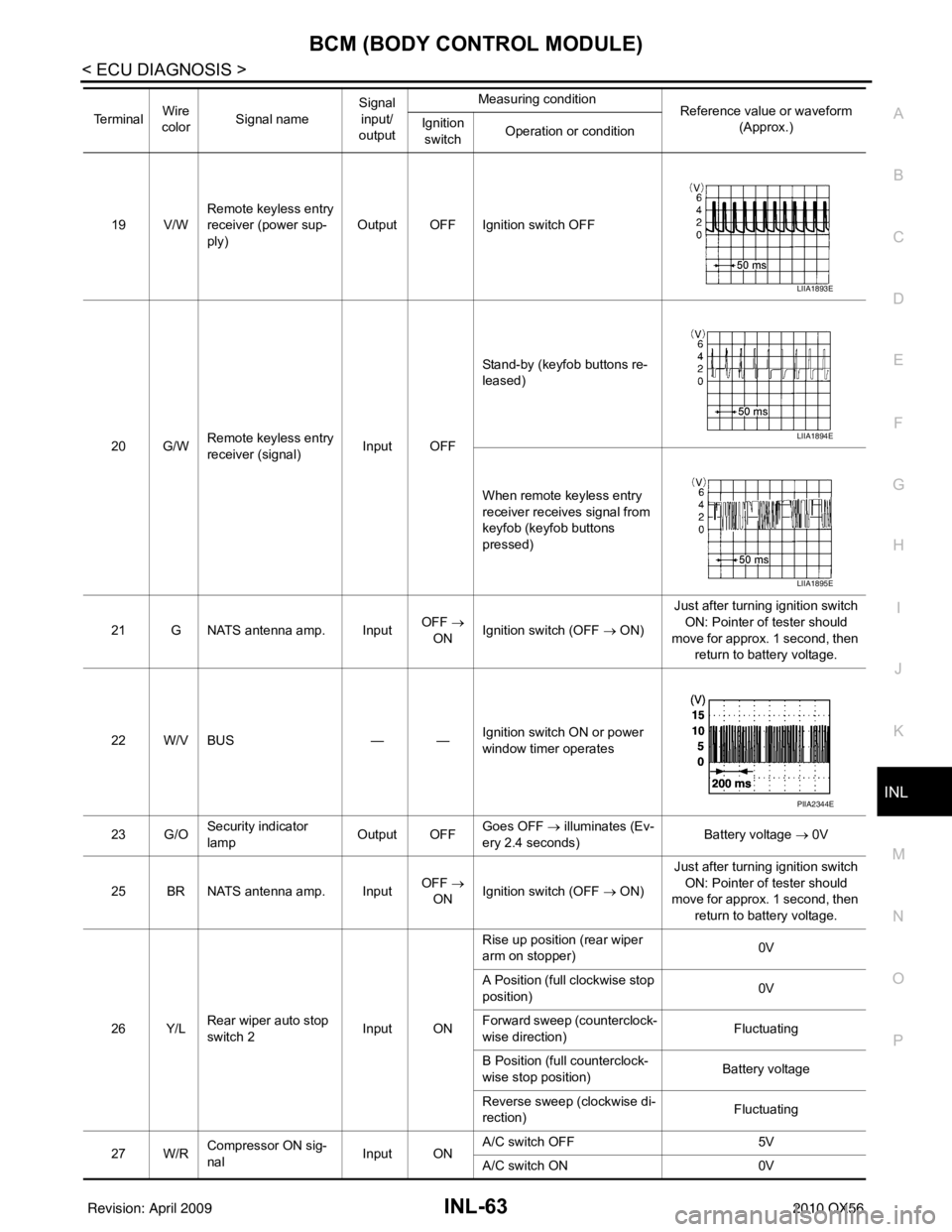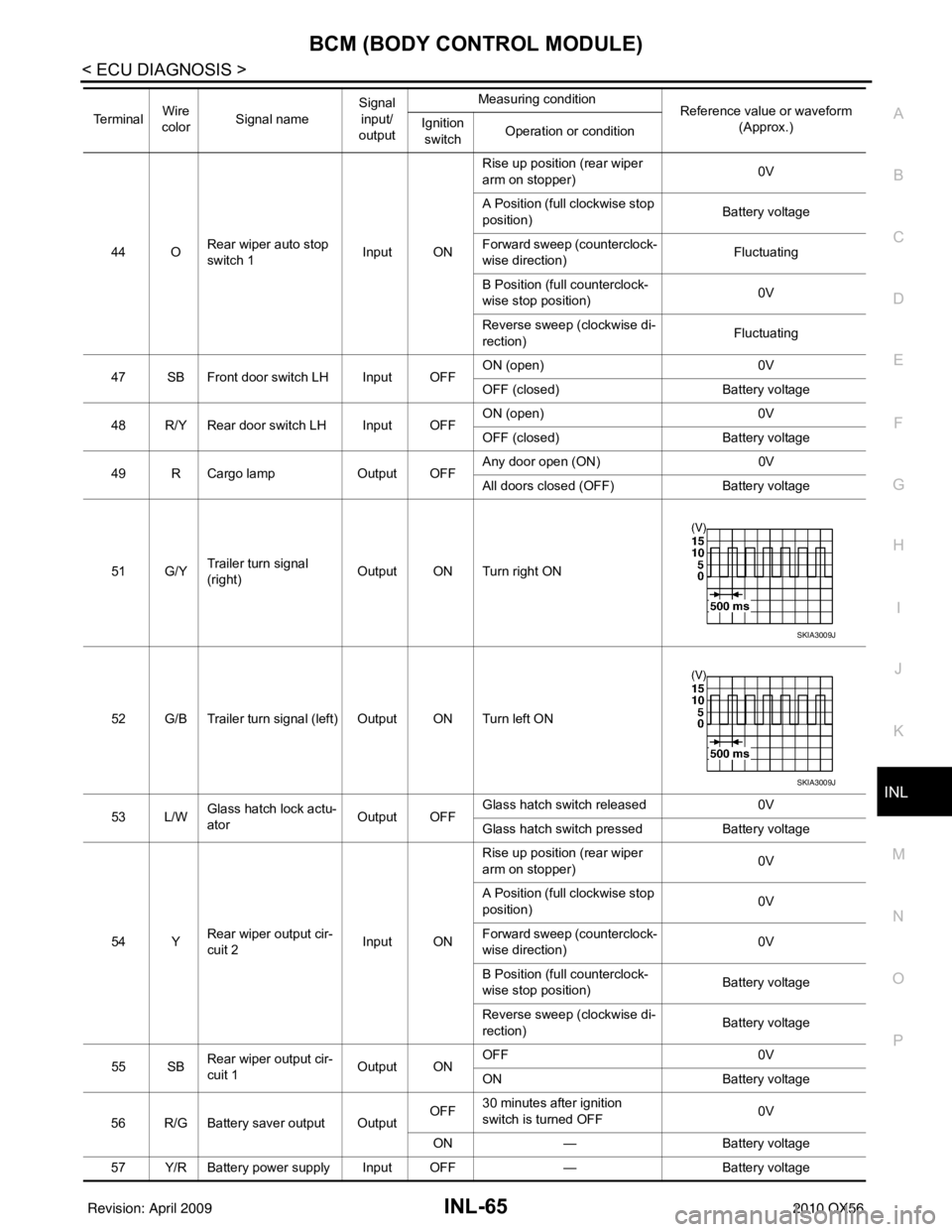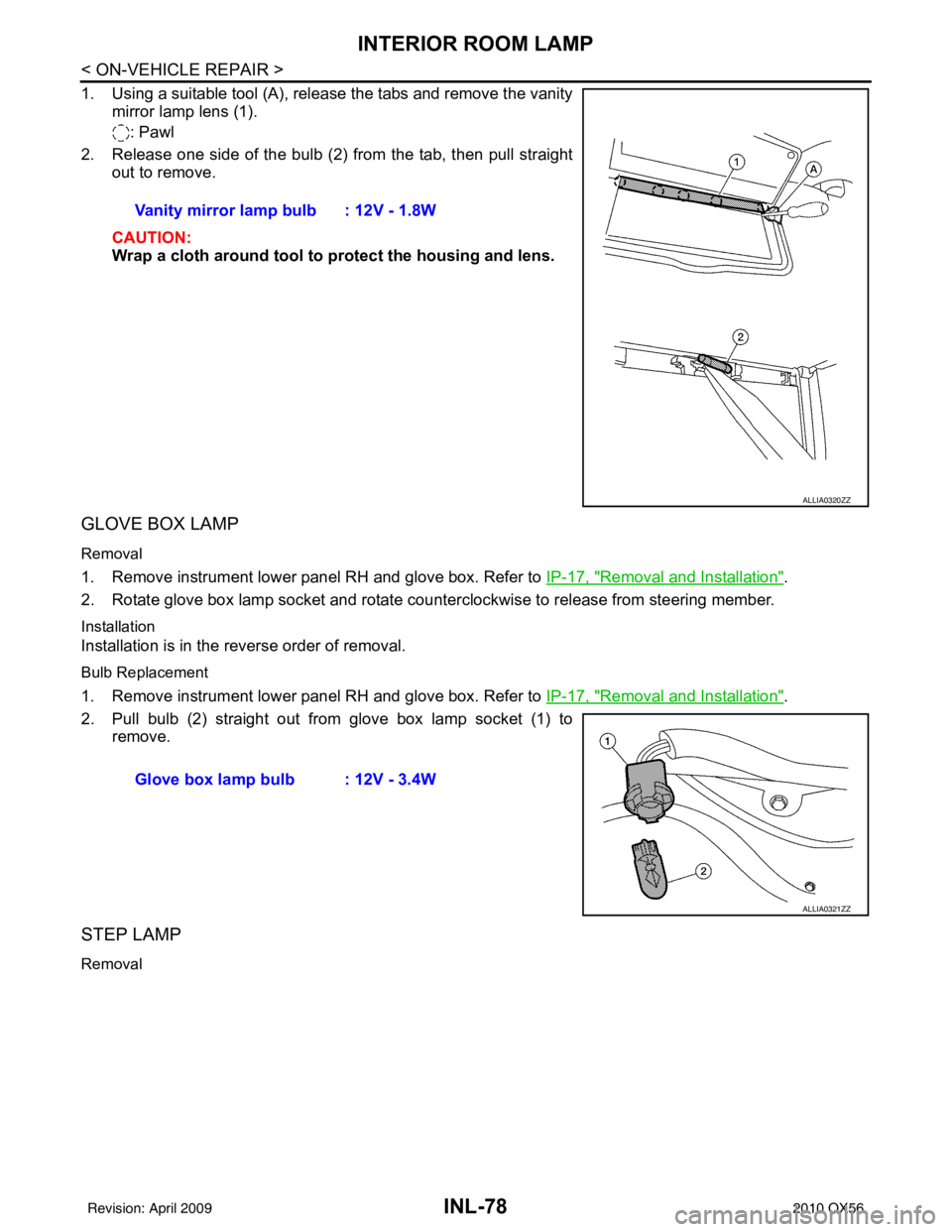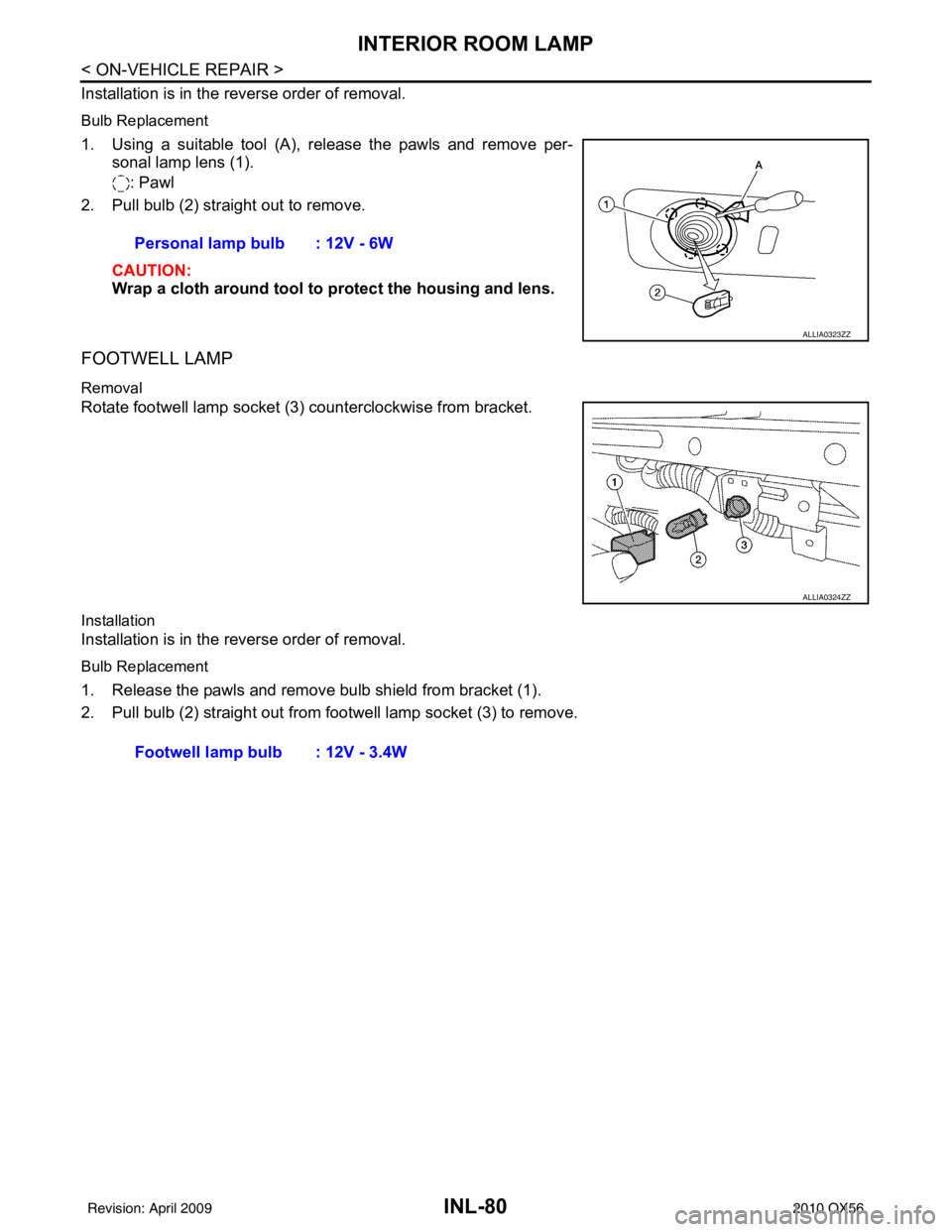2010 INFINITI QX56 clock
[x] Cancel search: clockPage 2430 of 4210
![INFINITI QX56 2010 Factory Service Manual HAC-90
< ECU DIAGNOSIS >[AUTOMATIC AIR CONDITIONER]
AIR CONDITIONER CONTROL
14 G/W Air mix door motor (passenger) CW ON Clockwise rotation
Battery voltage
15 Y/G Power supply for IGN ON- Battery volta INFINITI QX56 2010 Factory Service Manual HAC-90
< ECU DIAGNOSIS >[AUTOMATIC AIR CONDITIONER]
AIR CONDITIONER CONTROL
14 G/W Air mix door motor (passenger) CW ON Clockwise rotation
Battery voltage
15 Y/G Power supply for IGN ON- Battery volta](/manual-img/42/57032/w960_57032-2429.png)
HAC-90
< ECU DIAGNOSIS >[AUTOMATIC AIR CONDITIONER]
AIR CONDITIONER CONTROL
14 G/W Air mix door motor (passenger) CW ON Clockwise rotation
Battery voltage
15 Y/G Power supply for IGN ON- Battery voltage
17 W/G Air mix door motor (driver) CW ON Clockwise rotationBattery voltage
18 G Air mix door motor (driver) CCW ON Coun terclockwise rotationBattery voltage
19 BR/W Mode door motor CW (front) ON Clockwise rotationBattery voltage
20 P/L Mode door motor CCW ON Counterclockwise rotationBattery voltage
21 G/B Intake door motor CCW ON Counterclockwise rotationBattery voltage
22 O Intake door motor CW ON Clockwise rotationBattery voltage
23 LG Defroster door motor CW ON Clockwise rotationBattery voltage
24 P/B Defroster door motor CCW ON Counterclockwise rotationBattery voltage
25 P Ambient sensor ON- 0 - 5V
26 V/R Sensor ground ON- 0V
27 Y/R Power supply for BAT -- Battery voltage
28 Y V ref ACTR (5V) ON- 0 - 5V
29 R/W Air mix door motor (passenger) feed-
back
ON
- 0 - 5V
30 R/Y Mode door motor (Rear) feedback ON -0 - 5V
31 BR/Y In-vehicle sensor motor (+) ON- Battery voltage
32 LG/R In-vehicle sensor signal ON- 0 - 5V
33 R/Y Air mix door motor (Rear) feedback ON -0 - 5V
36 B Ground -- 0V
40 P CAN-L ON- 0 - 5V
41 L CAN-H ON- 0 - 5V
42 W/V Optical sensor (passenger) ON- 0 - 5V
43 GR/R Mode door motor (Rear) CW ON Clockwise rotationBattery voltage
44 L/Y Mode door motor (Rear) CCW ON Counterclockwise rotation Battery voltage
45 Y/L Water valve ONWater valve open
Battery voltage
Water valve closed 0V
46 W/G Water valve ONWater valve open
0V
Water valve closed Battery voltage
47 O LIN BUS (rear) ON- Battery voltage
48 O LIN BUS (front) ON- Battery voltage
49 GR/R Air mix door motor (Rear) CW ONClockwise rotation Battery voltage
50 L/Y Air mix door motor (Rear) CCW ON Counterclockwise rotation Battery voltage
Te r m i n a l
No. Wire
color ItemIgnition
switch Condition Voltage (V)
(Approx.)
Revision: April 20092010 QX56
Page 2448 of 4210
![INFINITI QX56 2010 Factory Service Manual HAC-108
< SYMPTOM DIAGNOSIS >[AUTOMATIC AIR CONDITIONER]
INSUFFICIENT COOLING
INSUFFICIENT COOLING
Component Function CheckINFOID:0000000005147735
SYMPTOM: Insufficient cooling
INSPECTION FLOW
1.CONFI INFINITI QX56 2010 Factory Service Manual HAC-108
< SYMPTOM DIAGNOSIS >[AUTOMATIC AIR CONDITIONER]
INSUFFICIENT COOLING
INSUFFICIENT COOLING
Component Function CheckINFOID:0000000005147735
SYMPTOM: Insufficient cooling
INSPECTION FLOW
1.CONFI](/manual-img/42/57032/w960_57032-2447.png)
HAC-108
< SYMPTOM DIAGNOSIS >[AUTOMATIC AIR CONDITIONER]
INSUFFICIENT COOLING
INSUFFICIENT COOLING
Component Function CheckINFOID:0000000005147735
SYMPTOM: Insufficient cooling
INSPECTION FLOW
1.CONFIRM SYMPTOM BY PERFORMING OPER
ATIONAL CHECK - TEMPERATURE DECREASE
1. Press the AUTO switch.
2. Turn temperature control dial (driver) counterclockwise until 18 °C (60 °F) is displayed.
3. Check for cold air at discharge air outlets.
Can the symptom be duplicated?
YES >> GO TO 3.
NO >> GO TO 2.
2.CHECK FOR ANY SYMPTOMS
Perform a complete operational check for any symptoms. Refer to HAC-4, "
Operational Check (Front)".
Does another symptom exist?
YES >> Refer to HAC-107, "SymptomMatrixChart".
NO >> System OK.
3.CHECK FOR SERVICE BULLETINS
Check for any service bulletins.
>> GO TO 4.
4.PERFORM SELF-DIAGNOSIS
Perform self-diagnosis Refer to HAC-23, "
A/C Auto Amp. Self-Diagnosis".
Is the inspection result normal?
YES >> GO TO 5.
NO >> Refer to HAC-24, "
A/C System Self-Diagnosis Code Chart".
5.CHECK DRIVE BELTS
Check compressor belt tension. Refer to EM-13, "
Checking Drive Belts".
Is the inspection result normal?
OK >> GO TO 6.
NG >> Adjust or replace compressor belt. Refer to EM-13, "
Removal and Installation".
6.CHECK AIR MIX DOOR OPERATION
Check and verify air mix door mechanism for smooth operation. Refer to HAC-31, "
Air Mix Door Motor (Driver)
Component Function Check".
Does air mix door operate correctly?
YES >> GO TO 7.
NO >> Check air mix door motor circuit. Refer to HAC-32, "
Air Mix Door Motor (Driver) Diagnosis Proce-
dure" or HAC-35, "Air Mix Door Motor (Passenger) Diagnosis Procedure".
7.CHECK COOLING FAN MOTOR OPERATION
Check and verify cooling fan motor for smooth operation. Refer to EC-392, "
Component Inspection".
Does cooling fan motor operate correctly?
YES >> GO TO 8.
NO >> Check cooling fan motor. Refer to EC-392, "
Diagnosis Procedure".
8.CHECK WATER VALVE OPERATION
Check and verify water valve for smooth operation. Refer to HAC-73, "
Description".
Does water valve operate correctly?
YES >> GO TO 9.
Revision: April 20092010 QX56
Page 2456 of 4210
![INFINITI QX56 2010 Factory Service Manual HAC-116
< SYMPTOM DIAGNOSIS >[AUTOMATIC AIR CONDITIONER]
INSUFFICIENT HEATING
INSUFFICIENT HEATING
Component Function CheckINFOID:0000000005147739
SYMPTOM: Insufficient heating
INSPECTION FLOW
1.CONFI INFINITI QX56 2010 Factory Service Manual HAC-116
< SYMPTOM DIAGNOSIS >[AUTOMATIC AIR CONDITIONER]
INSUFFICIENT HEATING
INSUFFICIENT HEATING
Component Function CheckINFOID:0000000005147739
SYMPTOM: Insufficient heating
INSPECTION FLOW
1.CONFI](/manual-img/42/57032/w960_57032-2455.png)
HAC-116
< SYMPTOM DIAGNOSIS >[AUTOMATIC AIR CONDITIONER]
INSUFFICIENT HEATING
INSUFFICIENT HEATING
Component Function CheckINFOID:0000000005147739
SYMPTOM: Insufficient heating
INSPECTION FLOW
1.CONFIRM SYMPTOM BY PERFORMING OPER
ATIONAL CHECK - TEMPERATURE INCREASE
1. Press the AUTO switch.
2. Turn the temperature control dial (driver) clockwise until 32 °C (90° F) is displayed.
3. Check for hot air at discharge air outlets.
Can this symptom be duplicated?
YES >> GO TO 2.
NO >> Perform complete system operational check. Refer to HAC-4, "
Operational Check (Front)".
2.CHECK FOR SERVICE BULLETINS
Check for any service bulletins.
>> GO TO 3.
3.PERFORM SELF-DIAGNOSIS
Perform self-diagnosis. Refer to HAC-23, "
A/C Auto Amp. Self-Diagnosis".
Is the inspection result normal?
YES >> GO TO 4.
NO >> Refer to HAC-24, "
A/C System Self-Diagnosis Code Chart".
4.CHECK ENGINE COOLING SYSTEM
1. Check for proper engine coolant level. Refer to CO-10, "
Inspection".
2. Check hoses for leaks or kinks.
3. Check radiator cap. Refer to CO-10, "
Inspection".
4. Check for air in cooling system.
>> GO TO 5.
5.CHECK AIR MIX DOOR OPERATION
Check the operation of the air mix door.
Is the inspection result normal?
YES >> GO TO 6.
NO >> Check the air mix door motor circuit. Refer to HAC-31, "
Air Mix Door Motor (Driver) Component
Function Check".
6.CHECK AIR DUCTS
Check for disconnected or leaking air ducts.
Is the inspection result normal?
YES >> GO TO 7.
NO >> Repair all disconnected or leaking air ducts.
7.CHECK HEATER HOSE TEMPERATURES
1. Start engine and warm it up to normal operating temperature.
2. Touch both the inlet and outlet heater hoses. The inlet hose should be hot and the outlet hose should be
warm.
Is the inspection result normal?
YES >> Hot inlet hose and a warm outlet hose: GO TO 8.
NO >> • Inlet hose cold: GO TO 11. • Both hoses warm: GO TO 9.
8.CHECK ENGINE COOLANT SYSTEM
Revision: April 20092010 QX56
Page 2462 of 4210
![INFINITI QX56 2010 Factory Service Manual HAC-122
< PRECAUTION >[AUTOMATIC AIR CONDITIONER]
PRECAUTIONS
If a refrigerant other than pure HFC-134a (R-134a)
is identified in a vehicle, your options are:
• Explain to the customer that environ INFINITI QX56 2010 Factory Service Manual HAC-122
< PRECAUTION >[AUTOMATIC AIR CONDITIONER]
PRECAUTIONS
If a refrigerant other than pure HFC-134a (R-134a)
is identified in a vehicle, your options are:
• Explain to the customer that environ](/manual-img/42/57032/w960_57032-2461.png)
HAC-122
< PRECAUTION >[AUTOMATIC AIR CONDITIONER]
PRECAUTIONS
If a refrigerant other than pure HFC-134a (R-134a)
is identified in a vehicle, your options are:
• Explain to the customer that environmental regulations prohibit the release of contaminated refrigerant into
the atmosphere.
• Explain that recovery of the contaminated refri gerant could damage your service equipment and refrigerant
supply.
• Suggest the customer return the vehicle to the location of previous service where the contamination may
have occurred.
• If you choose to perform the repair, recover the refrigerant using only dedicated equipment and contain- ers. Do not recover contamin ated refrigerant into your existing service equipment. If your facility does
not have dedicated recovery equipment, you may contact a local refrigerant product retailer for available ser-
vice. This refrigerant must be disposed of in acco rdance with all federal and local regulations. In addition,
replacement of all refrigerant system components on the vehicle is recommended.
• If the vehicle is within the warranty period, the air conditioner warranty is void. Please contact NISSAN Cus-
tomer Affairs for further assistance.
Precaution for Service EquipmentINFOID:0000000005147744
MANIFOLD GAUGE SET
Be certain that the gauge face indicates R-134a or 134a. Make sure
the gauge set has 1/2 ″-16 ACME threaded connections for service
hoses. Confirm the set has been used only with refrigerant HFC-
134a (R-134a) along with specified oil.
SERVICE HOSES
Be certain that the service hoses display the markings described
(colored hose with black stripe). All hoses must include positive shut-
off devices (either manual or aut omatic) near the end of the hoses
opposite the manifold gauge.
SERVICE COUPLERS
Never attempt to connect HFC-134a (R-134a) service couplers to a
CFC-12 (R-12) A/C system. The HFC-134a (R-134a) couplers will
not properly connect to the CFC-12 (R-12) system. However, if an
improper connection is attempted, discharging and contamination
may occur.
SHA533D
RHA272D
Shut-off valve rotati on A/C service valve
Clockwise Open
Counterclockwise Close
RHA273D
Revision: April 20092010 QX56
Page 2532 of 4210

BCM (BODY CONTROL MODULE)INL-63
< ECU DIAGNOSIS >
C
DE
F
G H
I
J
K
M A
B
INL
N
O P
19 V/W Remote keyless entry
receiver (power sup-
ply) Output OFF Ignition switch OFF
20 G/W Remote keyless entry
receiver (signal) Input OFFStand-by (keyfob buttons re-
leased)
When remote keyless entry
receiver receives signal from
keyfob (keyfob buttons
pressed)
21 G NATS antenna amp. Input OFF
→
ON Ignition switch (OFF → ON) Just after turning ignition switch
ON: Pointer of tester should
move for approx. 1 second, then return to battery voltage.
22 W/V BUS — —Ignition switch ON or power
window timer operates
23 G/O Security indicator
lamp Output OFF
Goes OFF
→ illuminates (Ev-
ery 2.4 seconds) Battery voltage
→ 0V
25 BR NATS antenna amp. Input OFF
→
ON Ignition switch (OFF → ON) Just after turning ignition switch
ON: Pointer of tester should
move for approx. 1 second, then return to battery voltage.
26 Y/L Rear wiper auto stop
switch 2 Input ONRise up position (rear wiper
arm on stopper)
0V
A Position (full clockwise stop
position) 0V
Forward sweep (counterclock-
wise direction) Fluctuating
B Position (full counterclock-
wise stop position) Battery voltage
Reverse sweep (clockwise di-
rection) Fluctuating
27 W/R Compressor ON sig-
nal Input ONA/C switch OFF
5V
A/C switch ON 0V
Te r m i n a l
Wire
color Signal name Signal
input/
output Measuring condition
Reference value or waveform
(Approx.)
Ignition
switch Operation or condition
LIIA1893E
LIIA1894E
LIIA1895E
PIIA2344E
Revision: April 20092010 QX56
Page 2534 of 4210

BCM (BODY CONTROL MODULE)INL-65
< ECU DIAGNOSIS >
C
DE
F
G H
I
J
K
M A
B
INL
N
O P
44 O Rear wiper auto stop
switch 1 Input ONRise up position (rear wiper
arm on stopper)
0V
A Position (full clockwise stop
position) Battery voltage
Forward sweep (counterclock-
wise direction) Fluctuating
B Position (full counterclock-
wise stop position) 0V
Reverse sweep (clockwise di-
rection) Fluctuating
47 SB Front door switch LH Input OFF ON (open)
0V
OFF (closed) Battery voltage
48 R/Y Rear door switch LH Input OFF ON (open)
0V
OFF (closed) Battery voltage
49 R Cargo lamp Output OFFAny door open (ON)
0V
All doors closed (OFF) Battery voltage
51 G/Y Trailer turn signal
(right) Output ON Turn right ON
52 G/B Trailer turn signal (left) Output ON Turn left ON
53 L/W Glass hatch lock actu-
ator
Output OFFGlass hatch switch released
0V
Glass hatch switch pressed Battery voltage
54 Y Rear wiper output cir-
cuit 2 Input ONRise up position (rear wiper
arm on stopper)
0V
A Position (full clockwise stop
position) 0V
Forward sweep (counterclock-
wise direction) 0V
B Position (full counterclock-
wise stop position) Battery voltage
Reverse sweep (clockwise di-
rection) Battery voltage
55 SB Rear wiper output cir-
cuit 1 Output ONOFF
0V
ON Battery voltage
56 R/G Battery saver output Output OFF
30 minutes after ignition
switch is turned OFF 0V
ON — Battery voltage
57 Y/R Battery power supply Input OFF —Battery voltage
Te r m i n a l
Wire
color Signal name Signal
input/
output Measuring condition
Reference value or waveform
(Approx.)
Ignition
switch Operation or condition
SKIA3009J
SKIA3009J
Revision: April 20092010 QX56
Page 2547 of 4210

INL-78
< ON-VEHICLE REPAIR >
INTERIOR ROOM LAMP
1. Using a suitable tool (A), release the tabs and remove the vanitymirror lamp lens (1).
: Pawl
2. Release one side of the bulb (2) from the tab, then pull straight out to remove.
CAUTION:
Wrap a cloth around tool to protect the housing and lens.
GLOVE BOX LAMP
Removal
1. Remove instrument lower panel RH and glove box. Refer to IP-17, "Removal and Installation".
2. Rotate glove box lamp socket and rotate counterclockwise to release from steering member.
Installation
Installation is in the reverse order of removal.
Bulb Replacement
1. Remove instrument lower panel RH and glove box. Refer to IP-17, "Removal and Installation".
2. Pull bulb (2) straight out from glove box lamp socket (1) to remove.
STEP LAMP
Removal
Vanity mirror lamp bulb : 12V - 1.8W
ALLIA0320ZZ
Glove box lamp bulb : 12V - 3.4W
ALLIA0321ZZ
Revision: April 20092010 QX56
Page 2549 of 4210

INL-80
< ON-VEHICLE REPAIR >
INTERIOR ROOM LAMP
Installation is in the reverse order of removal.
Bulb Replacement
1. Using a suitable tool (A), release the pawls and remove per-sonal lamp lens (1).
: Pawl
2. Pull bulb (2) straight out to remove.
CAUTION:
Wrap a cloth around tool to protect the housing and lens.
FOOTWELL LAMP
Removal
Rotate footwell lamp socket (3) counterclockwise from bracket.
Installation
Installation is in the reverse order of removal.
Bulb Replacement
1. Release the pawls and remove bulb shield from bracket (1).
2. Pull bulb (2) straight out from footwell lamp socket (3) to remove.Personal lamp bulb : 12V - 6W
ALLIA0323ZZ
ALLIA0324ZZ
Footwell lamp bulb : 12V - 3.4W
Revision: April 20092010 QX56